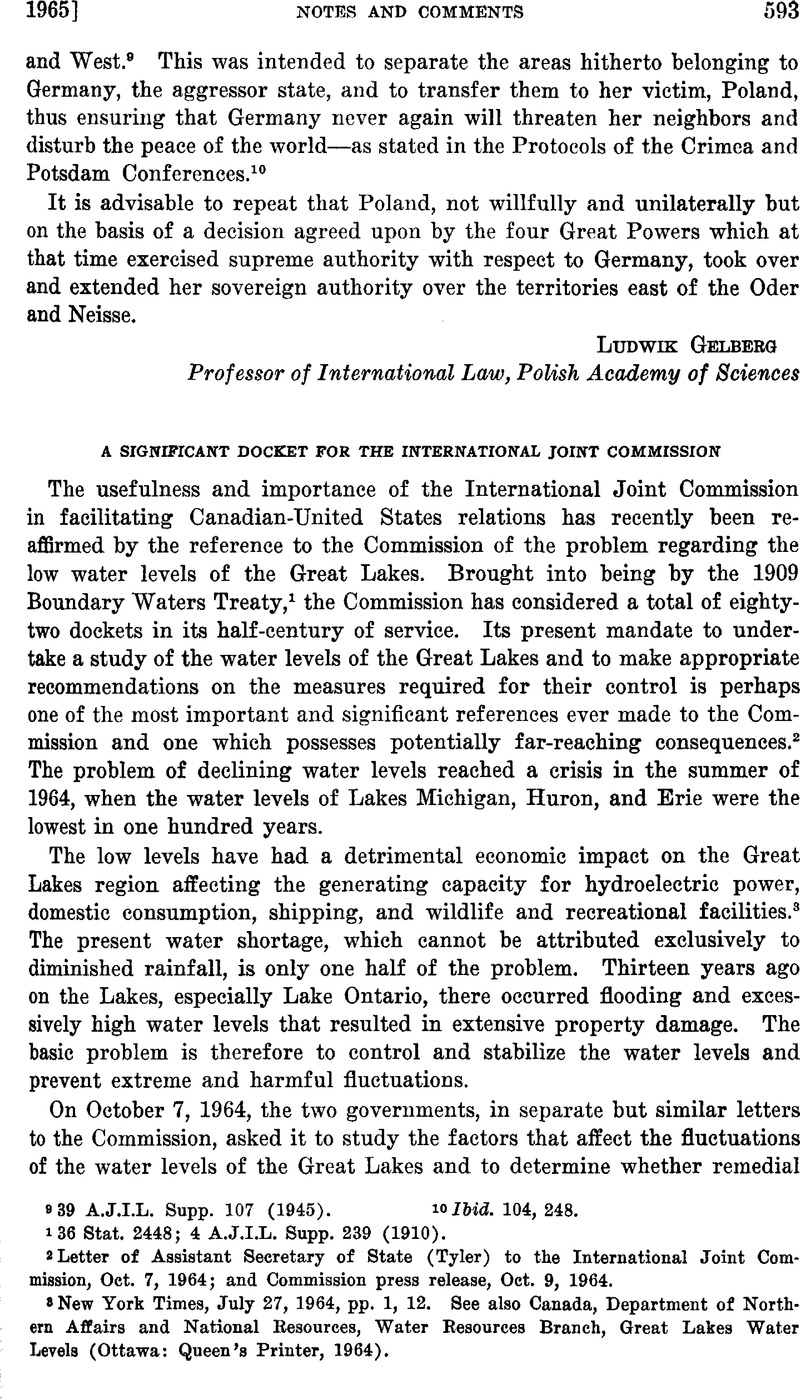Published online by Cambridge University Press: 28 March 2017

1 36 Stat. 2448; 4 A.J.I.L. Supp. 239 (1910).
2 Letter of Assistant Secretary of State (Tyler) to the International Joint Commission, Oct. 7, 1964; and Commission press release, Oct. 9, 1964.
3 New York Times, July 27, 1964, pp. 1, 12. See also Canada, Department of Northern Affairs and National Resources, Water Resources Branch, Great Lakes Water Levels (Ottawa: Queen's Printer, 1964).
4 See the Preliminary Article and Art. III of the Boundary Waters Treaty.
5 That article provides that either government may refer “any other questions or matters of difference arising between them involving the rights, obligations, or interests of either in relation to the other or to the inhabitants of the other, along the common frontier between the United States and the Dominion of Canada … to the International Joint Commission for examination and report… . “
6 See the testimony of a representative of the Army Corps of Engineers that the net loss on Lake Michigan amounts to 2% inches. U. S. Senate, Subcommittee on Merchant Marine and Fisheries of the Committee on Commerce, Hearings, Economic Impact of Low Water Levels in the Great Lakes, 88th Cong., 2d Sess., 1964, pp. 13-20, 26.
7 Letter of the Canadian Ambassador to the Acting Secretary of State, April 9, 1959; and letter of the Canadian Ambassador to the Secretary of State, Nov. 2, 1961.
8 Letter from the Assistant Secretary of State (Macomber) to the Chairman of the Senate Committee on Foreign Relations, Feb. 15, 1960.
9 The United States legal position would be predicated in part on the provisions of Art. II of the Boundary Waters Treaty which provides: “Each of the High Contracting Parties reserves to itself or to the several State Governments on the one side and the Dominion or Provincial Governments on the other as the case may be, subject to any treaty provisions now existing with respect thereto, the exclusive jurisdiction and control over the use and diversion, whether temporary or permanent, of all waters on its own side of the line which in their natural channels would flow across the boundary or into boundary waters; but it is agreed that any interference with or diversion from their natural channel of such waters on either side of the boundary, resulting in any injury on the other side of the boundary, shall give rise to the same rights and entitle the injured parties to the same legal remedies as if such injury took place in the country where such diversion or interference occurs; but this provision shall not apply to cases already existing or to cases expressly covered by special agreement between the parties hereto. ” It is understood, however, that neither of the High Contracting Parties intends by the foregoing provision to surrender any right, which it may have, to object to any interference with or diversions of waters on the other side of the boundary the effect of which would be productive of material injury to the navigation interests on its own side of the boundary.“ For a brief history of the Boundary Waters Treaty and a discussion of the rules of international law regarding diversions, see U. S. Senate, Legal Aspects of the Use of Systems of International Waters, 85th Cong., 2d Sess., 1958, Doc. 118.
10 See, for example, the letter from Senator Philip Hart to the Secretary of State, April 19, 1964; the letter from the then Chairman of the United States Section of the International Joint Commission (Teno Roncalio) to the President, April 28, 1964; and the comments of the Canadian Minister of Transport (J. W. pickersgill) in the document cited in note 6 above, pp. 4-9.
11 See note 9 above.
12 Art. VIII.
13 See Don C. Piper, ‘’ The Role of Intergovernmental Machinery in Canadian-American Relations,” 62 South Atlantic Quarterly 551-574 (1963).